Historic summit meeting held to determine the future of Masonic organizations
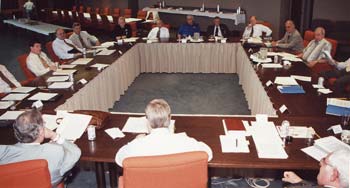
On Monday, April 17, 2000, a historic summit meeting of Masonic leaders was held at International Shrine Headquarters in Tampa. The meeting, sponsored by the Shrine of North America, was attended by representatives from all of the primary Masonic bodies throughout North America: representatives from the Shrine, from 10 Grand Lodge jurisdictions, the York Rite, the Scottish Rite Northern Masonic Jurisdiction, the Scottish Rite Southern Jurisdiction, and the Scottish Rite in Canada. It was the first-ever summit meeting of its kind in which all the Masonic bodies met together to discuss membership problems and prerequisite issues, and to explore ways to find solutions for the future.
Shrine leaders called the meeting to clarify the message of the Imperial Potentate's address at the recent Grand Masters Conference and to explore ways in which the Masonic bodies can work together for the future good of the Masonic and Shrine family of organizations.
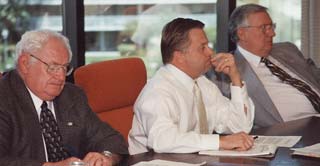 |
|
Imperial Chief Rabban Kenneth w. Smith, Imperial Potentate Ralph W. Semb, Deputy Imperial Potentate Robert N. Turnipseed |
The historic meeting resulted in an agreement to form a voluntary alliance of Masonic organizations, to be called the Intra Fraternal Masonic Alliance. The alliance will serve as a central clearinghouse for Masonic bodies throughout North America and seek to bring unity to Masonry's efforts to build membership by making Masonic fraternal involvement more meaningful and relevent.
The Alliance, which will be voluntary, will work toward developing a comprehensive, cooperative long-range plan to facilitate membership growth and retention and enhance Masonic cooperation and unity. It will require of participating bodies a commitment to Masonry, a financial commitment, a willingness to preserve the structure of Freemasonry and the Appendant Orders, as it now exists, and a willingness to experiment with constructive change for the good of Masonry. A steering committee is expected to be formed within a month to begin its work.
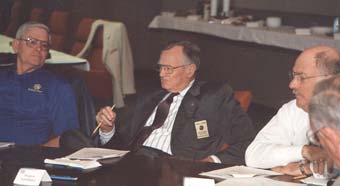 |
|
Grand Master of Oklahoma Lanny R. Sander, Grand Master of Maryland Francis E. Larrimore, Grand Master of Florida Keith Dean |
Following the meeting, the Shrine's Imperial Potentate Ralph W. Semb said, "I'm encouraged by the results of this historic meeting. The mood of the meeting was a bit cold initially but it ended with warmth on a very positive note. This meeting represents a positive step in bringing rivalries to an end by acknowledging that we're all in this together. We envision the Alliance as a way to help the Grand Lodges and all Masonic bodies manage change and strengthen membership without alienating important segments of existing Masonic membership."
The Shrine's Imperial Divan has agreed to fully support the alliance and to take a proactive position with the Representatives at the Imperial Council Session in Boston this summer, Semb added.
A full summary of the Intra Fraternal Masonic Alliance as approved by the participants at the Summit is reproduced below:
The Intra Fraternal Masonic Alliance
for the Survival and Success
of Freemasonry
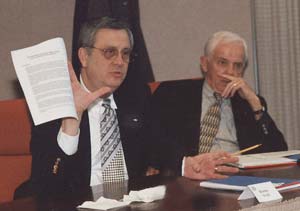 |
|
Lt. Sovereign Grand Commander Ronald A. Seale, Sovereign Grand Commander C. Fred Kleinknecht (Scottish Rite Southern Jurisdiction) |
Introduction
Freemasonry in North America has experienced 40 consecutive years of membership decline. Dramatic membership losses in Blue Lodge membership have, in turn, caused dramatic membership losses in Appendant Masonic organizations across the United States and Canada. One of the major problems in developing effective membership growth in the near future is the lack of an international intra fraternal alliance.
The idea of a Masonic family, working for the good of the entire fraternity, is a concept that is currently openly embraced by several Grand Jurisdictions. Limited conversations with Masonic leaders indicate they believe the formation of an Intra Fraternal Masonic Alliance throughout the United States and Canada is important, if not essential, to the preservation of the Masonic family concept.
This may well become the most unique national undertaking in the modern history of Freemasonry.
Purpose of an Intra Fraternal Masonic Alliance
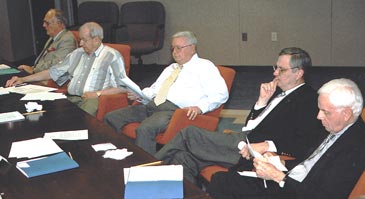 |
|
Grand Master of California Alvin J. Weis, Grand Master of Alberta Art Jones, Grand Master, Grand Encampment of Knights Templar James M. Ward, Lt. Sovereign Grand Commander Ronald A. Seale, Sovereign Grand Commander C. Fred Kleinknecht |
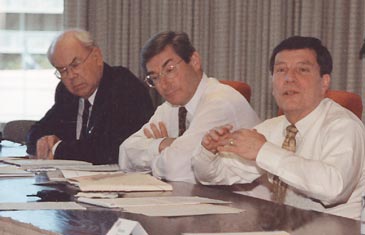 |
|
Sovereign Grand Commander Glenn M. Martin (A.A.S.R. Canada), Deputy for Massachusetts Robert Clarke (A.A.S.R. N.M.J.), Sovereign Grand Commander Robert O. Ralston (A.A.S.R. N.M.J.) |
The need for all Masonic organizations to join hands in an international effort to restore the relevance and growth of the Fraternity is long overdue. To do it with a refreshing new approach has much more appeal and is much more practical than to incorporate it into any existing organization like the Conference of Grand Masters, the Masonic Renewal Committee, or the Masonic Service Association, etc. The advantage of an Alliance is that it would be voluntary and, therefore, made up only of those Masonic organizations that want to be part of the solution to the problems common to all Alliance members.
Mission Statement
To establish and maintain an Alliance of Masonic Organizations, including Grand Lodges and Appendant and coordinate Masonic Organizations, for the singular and common purpose of developing and implementing strategies for their mutual survival and growth.
Implementation Plan
The Scottish Rites of the Northern Masonic Jurisdiction and the Southern Jurisdiction, the Canadian Supreme Council, and the Grand Encampment of Knights Templar of North America met prior to this Summit meeting, to review the concept and advantages of an Intra Fraternal Masonic Alliance (IFMA). They have unanimously endorsed the principle of the IFMA. In addition, the Grand Masters of Illinois, Pennsylvania and Massachusetts have endorsed the concept of the IFMA and have promised the full support of their Grand Lodges in its formation.
Thus, the concept of an intra fraternal strategic alliance (IFMA) is now in place.
If successful, the Alliance proposal will become the nucleus of future strategic planning for the participating Grand Lodges throughout the United States and Canada, the Shrine, Scottish Rite(s), York Rite(s), in the immediate future.
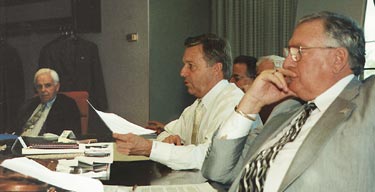 |
|
Sovereign Grand Commander C. Fred Kleinknecht, Imperial Potentate Ralph W. Semb, Deputy Imperial Potentate Robert N. Turnipseed |
We invite and hope that all present at this Summit Meeting will accept the Alliance proposal. We will expect to begin the implementation process before the end of May.
The many details of how the Alliance will be constructed and function are yet to be worked out by those who participate in its birth. Some preliminary guidelines on what it might mean and not mean are offered below.
What Alliance means, and does not mean
The following are talking points about what Alliance means
- Fundamentally, the Alliance is formed for the purpose of membership development, recovery, retention, and fraternal image building.
- The voluntary participants would accept some eligibility
requirements as a condition of membership. These might include:
- a signed commitment from all elected line officers that they will endorse the strategies adopted by the Alliance throughout their terms of office. Future line officers will sign on when they are elected.
- acknowledging a willingness to preserve the structure of
Freemasonry and the Appendant Orders, as it now exists.
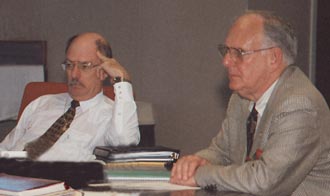
Grand Master of Florida Keith Dean, Grand Master of California Alvin J. Weis
- pledging full support of the financial plan that will develop to underwrite the budgetary needs of the Alliance, now and in the future. These needs may change as staff is hired, and when membership and image building programs are approved. Initially, operating funds will be collected from each participating organization based upon current membership (potentially 20 cents per member). Assessments may be required if approved by the governing organization.
- indicating a willingness to experiment with constructive change.
- supporting other commitments developed by the Alliance to assure implementation and continuity of the Intra Fraternal Masonic Alliance Strategic Plan.
The voluntary participants would expect to reap at least the following benefits from membership:
- comprehensive, cooperative, and successful plans for membership growth and retention
- international intra fraternal image building programs
- economies of scale
- an intra fraternal strategic (long range) plan
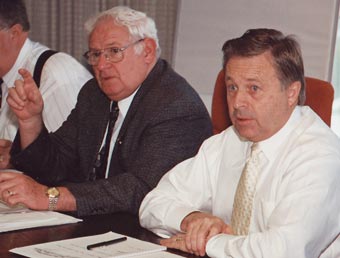
Imperial Chief Rabban Kenneth W. Smith, Imperial Potentate Ralph W. Semb
Conversely, the formation of Alliance will not mean:
- control over a participant organization. (Separate yet United)
- a forum for controversy with non-participants
Future Roadmap to Success
- On April 17, 2000, Commander Ralston (SCNMJ), proposed the
formation of the IFMA in which the Shrine, AASR, York Rite, and Grand
Lodges would participate as equal partners with other volunteer
Alliance Members.
- The IFMA presentation was discussed at length at the Summit
meeting and all participating Grand Masters in attendance went on
record as personally endorsing the concepts, principles and
requirements of the IFMA. They agreed to seek the full support of
their Grand Lodges as quickly as possible. A list of the participants
of the Summit is attached.
The Imperial Shrine of North America also agreed to fully support the Alliance and will take a proactive position with regard to Masonic unity with its representatives at the upcoming Imperial Session in Boston in July.
- Representatives to the Alliance implementation committee (Steering
Committee) will be selected. They will be empowered to act on behalf
of the organization in the development of the Alliance guidelines and
strategies.
They will report to the current leadership of the participating organizations for ratification of proposed strategies. Representatives will be chosen who have vision, and who have demonstrated positive and progressive attitudes and ideas about the survival and perpetual success of Freemasonry. Current heads of participating organizations will rarely act as Representatives in deference to their other leadership obligations.
- The nucleus group of voluntary participants will invite other
Grand Lodges and any remaining Appendant Orders to join the
Alliance.
- Regular meetings will be held to develop guidelines, requirements,
and strategies.
- A strategic plan will be implemented immediately.
- Strategic goals and objectives will be accomplished through immediate action plans.
Summit Conference Attendees
April 17, 2000
International Shrine HeadquartersRalph W. Semb Imperial Potentate
Robert N. Turnipseed, Deputy Imperial Potentate
Kenneth W. Smith, Imperial Chief Rabban
C. Fred Kleinknecht, Sovereign Grand Commander, A.A.S.R. S.J.
Robert 0. Ralston, Sovereign Grand Commander, A.A.S.R. N.M.J.
Glenn M. Martin, Sovereign Grand Commander, A.A.S.R. Canada
James M. Ward, Grand Master, Grand Encampment of Knights Templar
Ronald A. Seale, Lt. Sovereign Grand Commander, A.A.S.R. S.J.
Robert Clarke, Deputy for Massachusetts, A.A.S.R., N.M.J.
Art Jones, Grand Master of Alberta (Canadian Region)
Alvin J. Weis, Grand Master of California (Western Region)
Rodney W. Johnson, Grand Master of Colorado (Rocky Mountain Region)
Keith Dean, Grand Master of Florida
J. Garrie Burr, Grand Master of Illinois (Midwest Region)
Jim Durban, Deputy Grand Master of Illinois
Francis E. Larrimore, Grand Master of Maryland (Northeast Region)
Lanny R. Sander, Grand Master of Oklahoma (Southwest Region)
Gilbert Martin, Grand Master of South Carolina (Southeast Region)
Charles G. Cumpstone, Jr., Executive Vice President, A.A.O.N.M.S.